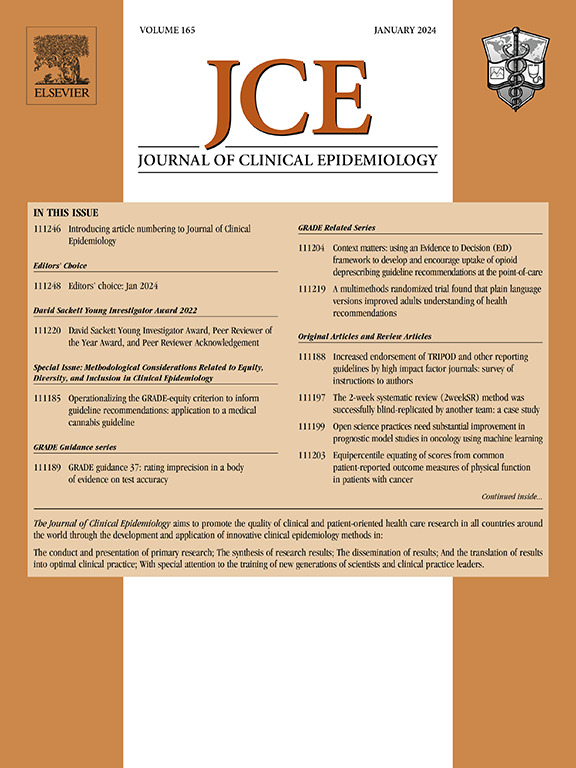可以通过自控病例系列和动态随机截距模型来评估先验事件率比法控制混杂因素的两个假设。
IF 7.3
2区 医学
Q1 HEALTH CARE SCIENCES & SERVICES
引用次数: 0
摘要
目的:先验事件发生率比是最近开发的一种方法,用于控制真实世界证据研究和观察性研究中已测量和未测量协变量的干扰。尽管这种方法在生物制药产品的安全性和有效性研究中越来越受欢迎,但在如何对其模型假设进行经验评估方面却没有指导。我们提出了两种方法来评估先验事件发生率所需的两个假设,具体来说,这两个假设是:结果事件的发生不会改变接受治疗的可能性,以及早期事件发生率不会影响后期事件发生率:我们建议分别使用自控病例系列(SCCS)和动态随机截距模型(DRIM)来评估上述两个假设。我们以非数学方式介绍了评估假设的方法及其应用。我们通过对西非冈比亚肺炎球菌疫苗接种和临床肺炎的去标识化数据进行二次分析来说明评估结果:对 12,901 名接种过疫苗的冈比亚婴儿数据进行的 SCCS 分析没有否定临床肺炎发作对接种肺炎球菌疫苗的可能性没有影响的假设。对 14,325 名婴儿共 1,719 次临床肺炎发作进行的 DRIM 分析没有否定早期临床肺炎发作对后期发病率没有影响的假设:SCCS和DRIM方法有助于适当使用先验事件发生率比值法来控制混杂因素。本文章由计算机程序翻译,如有差异,请以英文原文为准。
Two assumptions of the prior event rate ratio approach for controlling confounding can be evaluated by self-controlled case series and dynamic random intercept modeling
Objectives
The prior event rate ratio (PERR) is a recently developed approach for controlling confounding by measured and unmeasured covariates in real-world evidence research and observational studies. Despite its rising popularity in studies of safety and effectiveness of biopharmaceutical products, there is no guidance on how to empirically evaluate its model assumptions. We propose two methods to evaluate two of the assumptions required by the PERR, specifically, the assumptions that occurrence of outcome events does not alter the likelihood of receiving treatment, and that earlier event rate does not affect later event rate.
Study Design and Setting
We propose using self-controlled case series (SCCS) and dynamic random intercept modeling (DRIM), respectively, to evaluate the two aforementioned assumptions. A nonmathematical introduction of the methods and their application to evaluate the assumptions are provided. We illustrate the evaluation with secondary analysis of deidentified data on pneumococcal vaccination and clinical pneumonia in The Gambia, West Africa.
Results
SCCS analysis of data on 12,901 vaccinated Gambian infants did not reject the assumption of clinical pneumonia episodes had no influence on the likelihood of pneumococcal vaccination. DRIM analysis of 14,325 infants with a total of 1719 episodes of clinical pneumonia did not reject the assumption of earlier episodes of clinical pneumonia had no influence on later incidence of the disease.
Conclusion
The SCCS and DRIM methods can facilitate appropriate use of the PERR approach to control confounding.
Plain Language Summary
The prior event rate ratio is a promising approach for analysis of real-world data and observational studies. We propose two statistical methods to evaluate the validity of two assumptions it is based on. They can facilitate appropriate use of the prior even rate ratio.
求助全文
通过发布文献求助,成功后即可免费获取论文全文。
去求助
来源期刊

Journal of Clinical Epidemiology
医学-公共卫生、环境卫生与职业卫生
CiteScore
12.00
自引率
6.90%
发文量
320
审稿时长
44 days
期刊介绍:
The Journal of Clinical Epidemiology strives to enhance the quality of clinical and patient-oriented healthcare research by advancing and applying innovative methods in conducting, presenting, synthesizing, disseminating, and translating research results into optimal clinical practice. Special emphasis is placed on training new generations of scientists and clinical practice leaders.
 求助内容:
求助内容: 应助结果提醒方式:
应助结果提醒方式:


